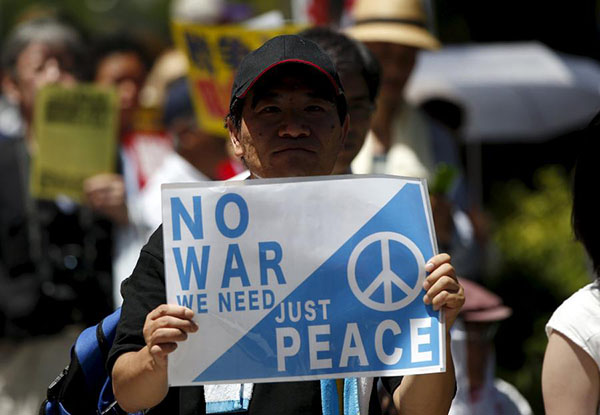Yasukuni homages show how hollow Abe's words were
Updated: 2015-08-17 07:58
By Cai Hong(China Daily)
|
|||||||||
 |
|
A protester holds a placard during a rally against Japan's Prime Minister Shinzo Abe's administration and his security-related legislation in front of the parliament building in Tokyo, July 15, 2015. [Photo/Agencies] |
'For the sake of His Majesty the Emperor, I am about to take up my calling in the eternal great cause in the skies of the decisive battle to destroy the Americans and British. There is no greater long-cherished desire for a man."
These words come from a final note to his family members written by Tetsuji Kizaki, a Japanese solider who was killed on Mindoro Island in the Philippines on January 3, 1945 at age of 23.
This note is the pick the Yasukuni Shrine is displaying on the way to its main hall this month.
More than 2.4 million souls of Japan's "fallen heroes", those who died in military service, are enshrined there. And more than 86 percent of them died in the Greater East Asia War - a term adopted by Japan's cabinet to refer to both the war Japan waged in China from the early 1930s and the Pacific War - among them convicted Class-A war criminals.
Following Japanese Prime Minister Shinzo Abe's remarks on Friday to mark the 70th anniversary of Japan's surrender, three of his cabinet members and a large group of the country's lawmakers paid homage at the controversial shrine on Saturday. Abe sent a cash offering to the shrine. He has not visited in person after the worldwide censure he received following his last visit in December 2013.
Abe, who cudgeled his brains for the words he used in his speech, especially the ones on the war his country launched almost 80 years ago said Japan "must squarely face the history of the past".
Yet he and those government officials and lawmakers do exactly the opposite by visiting the shrine.
Yasukuni is controversial for its revisionist interpretation of Japan's wartime history: A view that exonerates rather than atones.
Within its compound, the shrine has a memorial to Radhabinod Pal, the only one of the 11 Allied justices to find Japan's top wartime leaders not guilty at the International Military Tribunal for the Far East. His memorial received a wreath from a Japanese lawmaker on Saturday, although, he too found "the evidence is still overwhelming that atrocities were perpetrated by the members of the Japanese armed forces against the civilian population of some of the territories occupied by them, as also against the prisoners of war."
The Yushukan Museum, standing on the grounds of the Yasukuni Shrine, elaborates on the Greater East Asia Co-Prosperity Sphere, a concept then foreign minister Matsuoka Yosuke came up with in 1940, in a bid to portray Japan's aggression as a noble effort to liberate fellow East Asians from European and American colonial imperialists.
Some people suggest that Japan can settle the controversy of the Yasukuni Shrine by delisting the war criminals or building a new shrine. Yasukuni, however, has made it a rule not to delist anyone enshrined. It has even rejected demands from people in the Republic of Korea and China's Taiwan to remove the names of their relatives listed as the spirits of Japanese war dead.
Japan's right-wingers have taken the Shinto shrine as a symbol of self-sacrifice and patriotism. Some of them, in Imperial Japanese army uniforms and carrying banners, are allowed to call for the revival of the defunct Japanese empire at every anniversary of Japan's surrender on Aug 15, 1945.
So while Abe and his cabinet cannot shun the Yasukuni, the "deep remorse" and "heartfelt apology" are nothing but empty words.
The author is China Daily's Tokyo bureau chief. caihong@chinadaily.com.cn
- Global health entering new era: WHO chief
- Brazil's planning minister steps aside after recordings revelation
- Vietnam, US adopt joint statement on advancing comprehensive partnership
- European border closures 'inhumane': UN refugee agency
- Japan's foreign minister calls A-bombings extremely regrettable
- Fukushima impact unprecedented for oceans: US expert

 Stars of Lijiang River: Elderly brothers with white beards
Stars of Lijiang River: Elderly brothers with white beards
 Wealthy Chinese children paying money to learn British manners
Wealthy Chinese children paying money to learn British manners
 Military-style wedding: Fighter jets, grooms in dashing uniforms
Military-style wedding: Fighter jets, grooms in dashing uniforms
 Striking photos around the world: May 16 - May 22
Striking photos around the world: May 16 - May 22
 Robots help elderly in nursing home in east China
Robots help elderly in nursing home in east China
 Hanging in the air: Chongqing holds rescue drill
Hanging in the air: Chongqing holds rescue drill
 2.1-ton tofu finishes in two hours in central China
2.1-ton tofu finishes in two hours in central China
 Six things you may not know about Grain Buds
Six things you may not know about Grain Buds
Most Viewed
Editor's Picks

|

|

|

|

|

|
Today's Top News
Liang avoids jail in shooting death
China's finance minister addresses ratings downgrade
Duke alumni visit Chinese Embassy
Marriott unlikely to top Anbang offer for Starwood: Observers
Chinese biopharma debuts on Nasdaq
What ends Jeb Bush's White House hopes
Investigation for Nicolas's campaign
Will US-ASEAN meeting be good for region?
US Weekly

|

|









